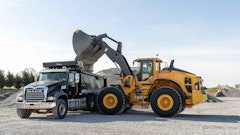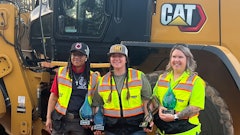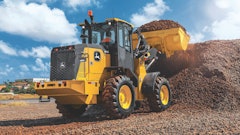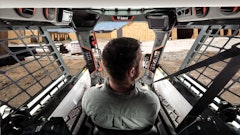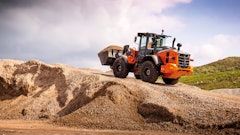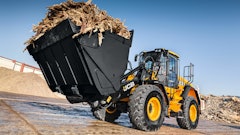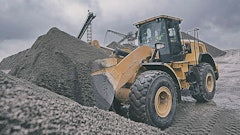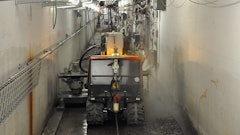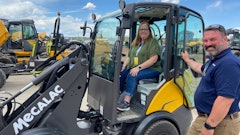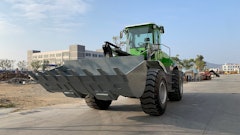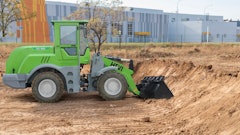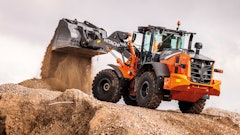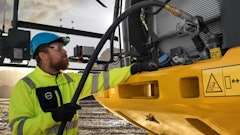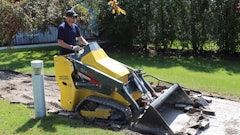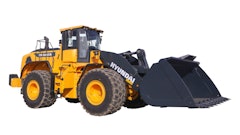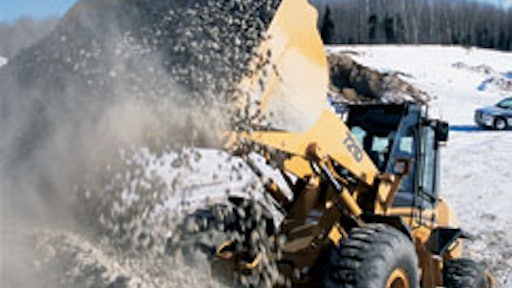
Material management is critical to an efficient asphalt plant. Those who focus attention on the efficiency of their loader operations can achieve significant gains in productivity and profitability.
While manufacturers have done their share to boost efficiency with electronic controls, new hydraulic technologies and ergonomically designed cabs, decisions made at the jobsite will be the primary factor in how quickly and safely the work gets done. Properly preparing the site is an essential first step.
"Too often, operators don't take the time to prepare a place to load and unload, and then time is wasted dealing with uneven ground surface, resetting loads and poorly placed trucks," says Dan Snedecor, product manager for Volvo wheel loaders.
Provide room to maneuver
Snedecor says there should be sufficient space for trucks to enter and exit the site. In addition, the storage and loading/unloading areas should be carefully positioned to ensure the loaders have adequate space to move about efficiently.
"Operators shouldn't have to maneuver around several piles or bundles of material when moving between locations," adds Mike Keery, marketing representative for small wheel loaders at Caterpillar Inc.
The loading/unloading path should be designed so that trucks can back up to the pile at a 45-degree angle on the left side of the loader. This will minimize the distance between the pile and the truck, and will allow the truck's driver to maintain visual contact with both the loader and the loader operator.
"The loader operator should then position the machine in the dumping position and direct the truck to back under the bucket, parallel to the loader pins," says Keery. "This will create a pattern that minimizes loader movement and maximizes loading efficiency."
Once the path has been established, it should be "groomed" and maintained. Muddy or soft conditions can consume a lot of the machine's rim pull, slowing down production and increasing fuel consumption.
"Keep the work area clear of debris because rocks and ruts can affect the balance of the wheel loader, especially with the arms lifted," says David Wolf, marketing manager for Case CE loaders.
"While waiting for a truck, operators should use the loader to keep the working area clean," Keery says. "A smooth, firm working area can dramatically improve your loader's efficiency and reduce tire wear."
The right attachment
Matching equipment to jobsite requirements is also key to efficiency. While new bracket designs have made it much easier to change attachments, many operators still try to do everything with one tool.
And while most contractors are familiar with forks and buckets, many are not aware of the other tools they can use to improve efficiency. These include brooms, material-handling arms, grading buckets, barrel handlers and boom suspension systems that can reduce material spillage and increase travel speed.
Manufacturer improvements
Efficiency gains can also be realized with new loader designs and technologies. For example, load-sensing hydraulics give the operator complete hydraulic control at low engine speeds, eliminating the need to rev the engine to complete tasks in close quarters.
Hydrostatic transmissions also allow operators to precisely match engine speed to the work being done. One of Komatsu's new wheel loaders, for example, is equipped with a variable shift control switch that allows the operator to set a maximum speed of up to 8.1 mph.
On its larger wheel loaders, Liebherr Construction Equipment Co. has added two hydraulic motors, each with a separate clutch, to the transmission. "We use various combinations of these motors to achieve optimal operational and fuel efficiency," says George Seyrlehner, Liebherr's product manager for wheel loaders. "At least one motor is in operation when the machine is accelerated or braked, resulting in continuous power flow."
Hydraulically driven fans on loaders can lower fuel consumption and make more engine power available for primary functions. In addition, the fan flow can be reversed, which is useful for purging debris from the cooling system area.
Electronic controls provide several efficiency-improving features. They create a communications link between the engine and transmission to ensure the selection of the most efficient gear based on engine speed and load. They also make automated functions possible. Case loaders, for example, have "Return to Dig" and "Return to Travel" settings that optimize settings for load and carry applications or truck loading.
Other efficiency-enhancing features include limited-slip axles, which transfer power away from a slipping axle to improve traction, and load scales that measure how much has been loaded into a specific truck. "Trucks that are overfilled won't last as long and can lead to citations and fines," says Keery. "Underfilled trucks aren't fully utilized, which lowers efficiency."
Last but not least, designers have revamped the cab to improve efficiency by reducing operator stress and fatigue. They have simplified controls, improved visibility and made the cab more comfortable.
"Modern, ergonomic cab designs and excellent ride quality keep the operator free from fatigue for longer periods of time, which results in higher productivity," says Seyrlehner. "Travel gear and power hydraulics can be precisely controlled from a single lever, reducing the operator's physical effort and the risk of errors."
Operational procedures
Additional efficiencies can be achieved by an experienced operator. Following are some recommended practices:
- Don't allow the loader to idle for more than 10 minutes. Unnecessary idling wastes fuel.
- Allow the machine to do the shifting. Auto-shift transmissions determine the best gear for specific loads and tasks, which improves fuel efficiency and allows the loader to travel at maximum controlled speeds.
- Don't spin the tires when entering a pile. "Buckets are filled effectively by penetrating the pile and manipulating the bucket and arms," says Wolf. "When tires are spinning, you are not penetrating the pile. You are losing production and increasing tire wear."
- Check tire pressure. "Properly inflated tires have a dramatic effect on the load-carrying capacity," says Keery. Uneven tire pressure can cause the loader to lean to one side, which will cause uneven wear on the bucket's cutting edge.
- Tire selection also is important. Radial tires provide superior ride quality and traction, which improves machine handling.
- Fill the fuel tank at the end of each workday. This will help prevent condensation in the tank and eliminate the need for a fuel stop during the workday.
Onboard weighing can improve loading accuracy
Onboard weighing systems can serve as the "eyes and ears" of equipment managers seeking to track wheel loader performance. As load data is captured, it is transferred to computers where it can be used to determine whether the loaders are being used as productively and efficiently as possible.
The primary function of an onboard weighing system is to weigh and display each load as it is being lifted so that a truck can be correctly loaded the first time. Most systems have the ability to calculate how much additional material is required for the truck to meet its legal limit, giving the loader operator the ability to adjust the final load as needed.
"Operators don't like to be loading by guesswork or loading blind," notes Leo Smith, managing director of Loadrite. "They prefer knowing how much is going on as they are loading, so that they can load the truck accurately."
Truck drivers are also ensured they are loaded to legal capacity and are not a candidate for an overload fine. Correctly loaded vehicles also perform in a predictable way, allowing drivers to maintain their expected braking distance and track reliably around corners. In addition, fleet managers benefit from lower maintenance costs since their trucks are not exposed to excessive wear and tear as a result of accidental overloading.
Data captured at the time of loading can be transferred back to an office computer for ongoing analysis and review. This transfer can happen in real time via the use of a radio modem, or a data capsule can be taken from the weighing system and plugged into the computer at the end of the shift or the end of the day.
Onboard weighing systems can be integrated with dedicated printers to create dockets as soon as a load-out is complete. Load information can be captured real time and/or stored to create reports that will improve management of the loading process.
When comparing available onboard weighing systems, consider the following:
- How versatile is the system? Can it be installed on any make or model of loader?
- How robust is the system? Will it perform accurately and repeatedly over time or will it require ongoing calibration and maintenance?
- Is the system easy to use?
- How does the system manage the transfer of data? Is the company experienced in this field of expertise?
- Does the system come with a warranty? Does the company have a support network in place to support the warranty?
- Can you lease the equipment? It might be that you can enjoy the benefits of an onboard weighing system without having to tie up your capital.
Information provided by Bill Cayce, Northern California USA Distributor, Loadrite North America Ltd.







